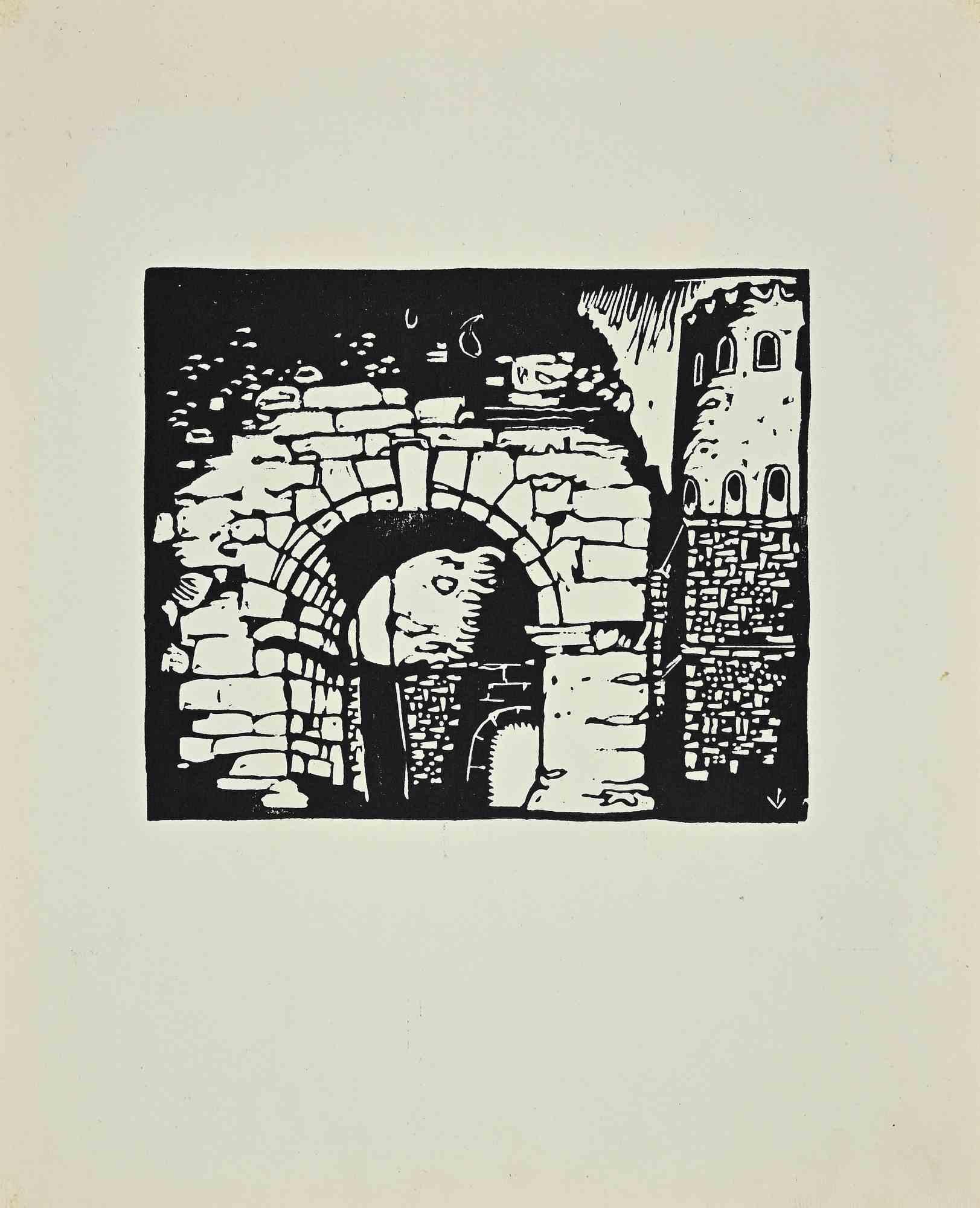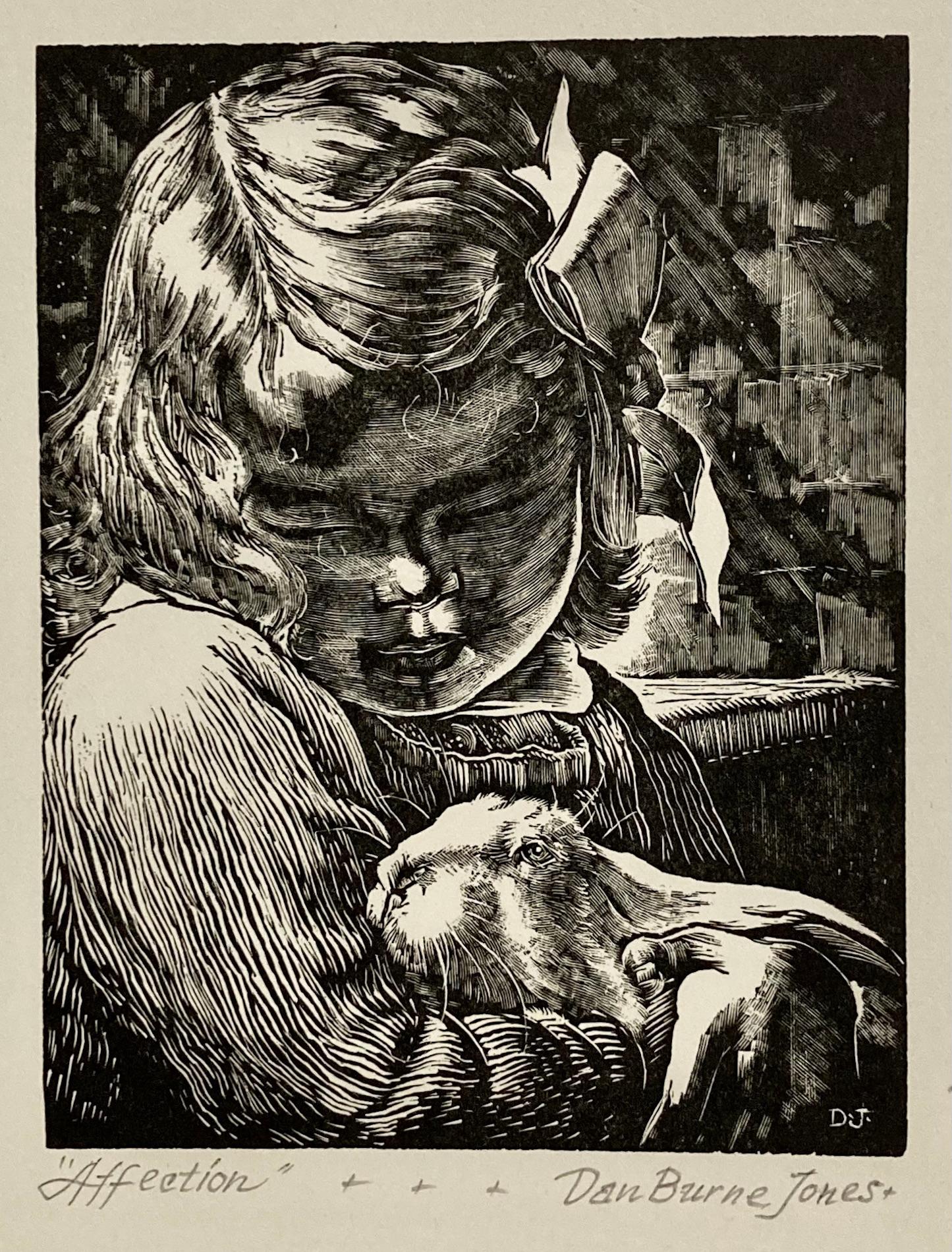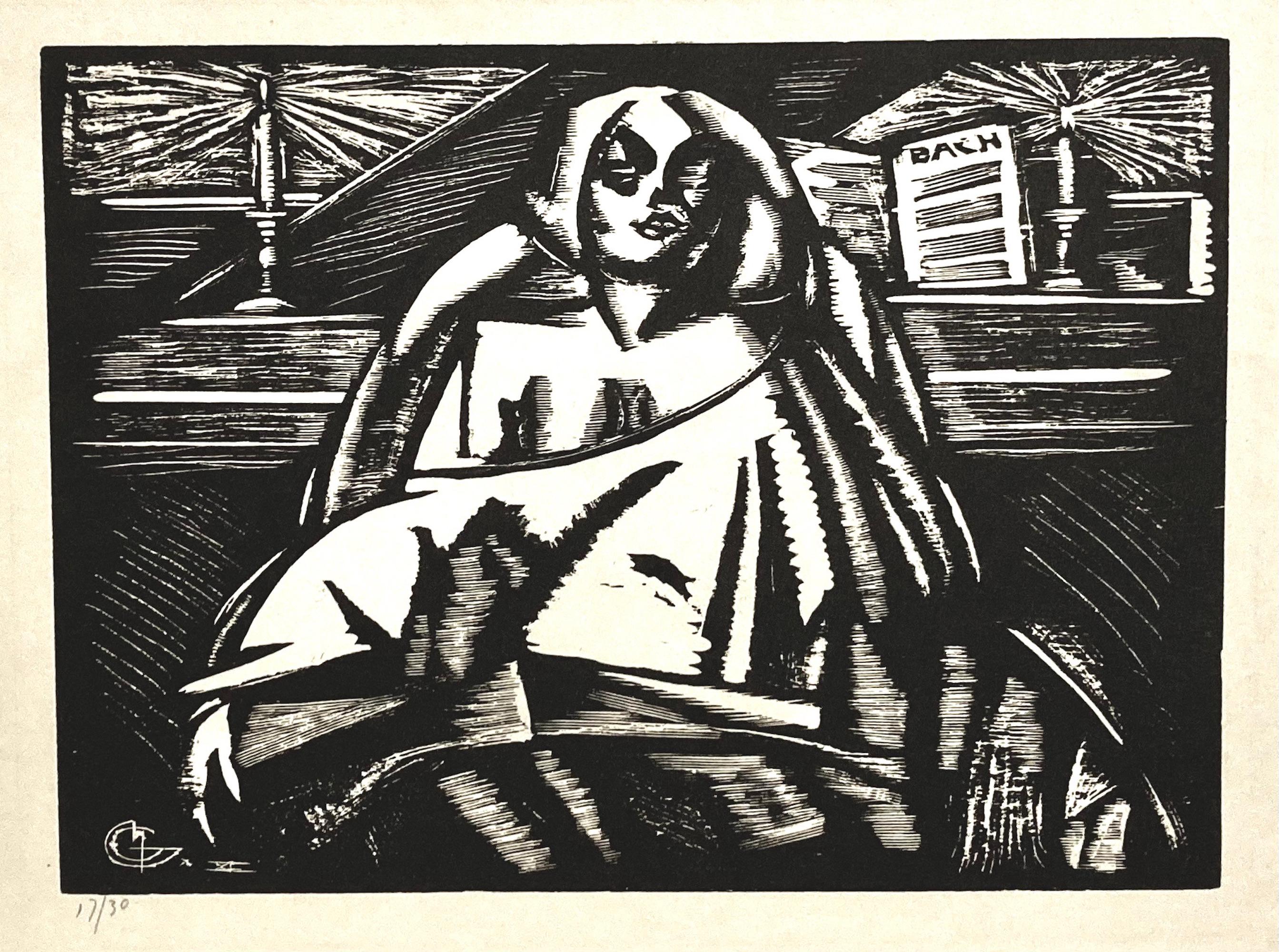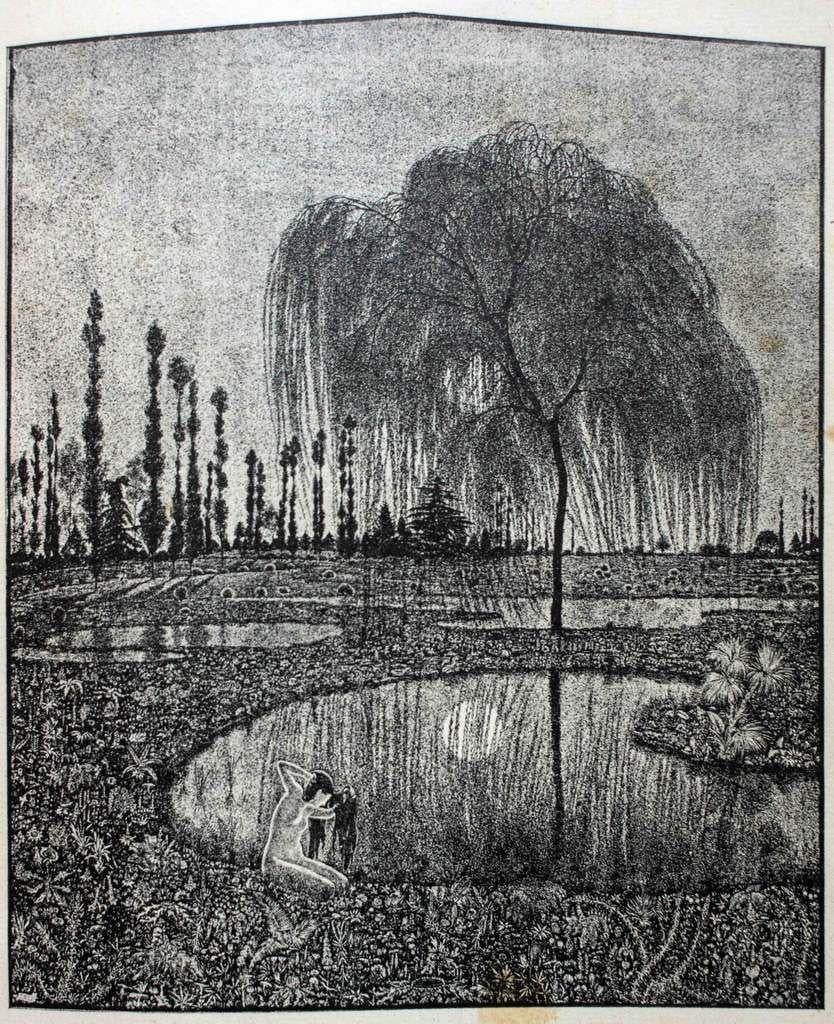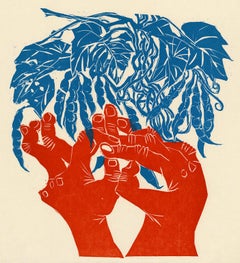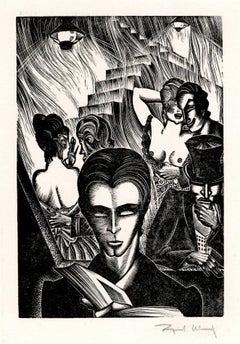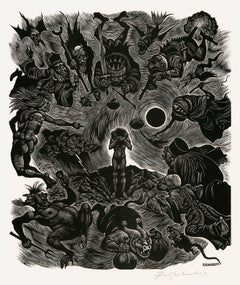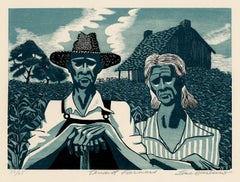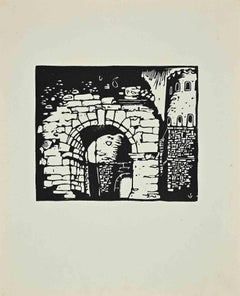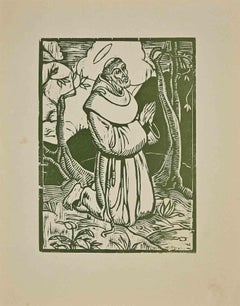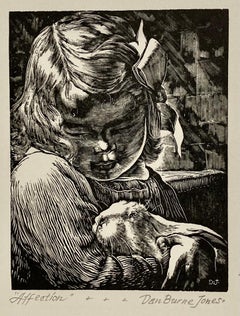Items Similar to 'Sailing' — Modernism, New York City WPA
Want more images or videos?
Request additional images or videos from the seller
1 of 3
Fred Becker'Sailing' — Modernism, New York City WPAc. 1935
c. 1935
About the Item
Fred Becker, 'Sailing', wood engraving, c. 1935, edition c. 25. Signed and titled in pencil. A fine, richly-inked impression, on off-white wove paper; with full margins (1 to 2 15/16 inches), in excellent condition. Scarce.
Created for the Works Progress Administration (WPA), Federal Art Project, New York. Matted to museum standards, unframed.
Image size 8 1/2 x 9 1/2 inches (216 x 242 mm); sheet size 11 1/8 x 17 1/2 inches (282 x 445 mm).
Literature: 'American Prints in the Library of Congress', The Johns Hopkins Press, Baltimore, 1970.
Other impressions of this work are held in the collections of the Art Institute of Chicago, Library of Congress, Metropolitan Museum of Art, New York Public Library, and the Philadelphia Museum of Art.
ABOUT THE ARTIST
Artist, printmaker, and professor Frederick Becker (1913-2004) was born in Oakland, California, and was raised in Hollywood, where his father was a silent film actor. He studied at the Otis Art Institute and, in 1933, moved to New York to study architecture at New York University, finding his calling in the fine arts. In 1934, he studied with Eugene Steinhof at the Beaux-Art Institute of Design in New York, and the following year, Becker was accepted into the New York Graphic Arts Division of the Works Progress Administration, where he received early recognition for his distinctive work as a printmaker of wood engravings and linocuts.
Influenced by the social and political climate of the great depression, he explored themes of human struggle, urban life, and the impact of industrialization on society. Becker’s experiences moonlighting as a caricaturist in New York’s nightclubs informed his dynamic and often surreal compositions with his personal blend of irony and humanism.
in 1940, he enrolled in the inaugural class of Atelier 17, the innovative New York graphics workshop established by British artist Stanley William Hayter. By the middle of the decade, Becker had become one of the most versatile technicians in the workshop, and he was among the artists who assisted Hayter with printing his own works. During this period, Becker turned to abstraction, employing color print techniques developed at Atelier 17. By the mid-1950s, his style had evolved from Surrealism to Abstract Expressionism.
Following his service in World War II, Becker accepted a teaching position at the Tyler School of Art in Philadelphia in 1946. Two years later, he went to Washington University in St. Louis, where he created the printmaking department and taught for twenty years. He went on to teach at the Fine Arts Department of the University of Massachusetts from 1968 to 1986.
Becker received a Tiffany Fellowship in 1948, a Yaddo stay in 1954, and a Guggenheim Foundation Fellowship and a National Endowment for the Arts Award in 1957. With the Guggenheim Fellowship, Becker traveled to Paris to work at Hayter’s original Atelier 17.
Becker has had numerous exhibitions, including retrospectives at the Herter Gallery; the University of Massachusetts, Amherst; Molloy College, Rockville Center, NY, 1999; and an Exhibition of Prints, Union College, and Schenectady, NY, January/February 2002. His work is included in Breaking Ground: Printmaking in the US, 1940-1960 at the Philadelphia Museum of Art (2016); and in exhibitions celebrating the impact of Atelier 17 on 20th Century American Art at the Museum of Modern Art (1944), Syracuse University Galleries (2016), Baltimore Museum of Art (2017), and the Cleveland Museum of Art (2017). Becker’s graphic work has been included in six exhibitions at the Museum of Modern Art from 1936 to 1995 and in three exhibitions at the Whitney Museum of American Art from 1938 to 2013
Over the course of his prolific career, Becker left a lasting mark on the American art scene, earning recognition for his technical virtuosity and his commitment to innovative artistic expression. Becker's graphic works are represented in the collections of the Library of Congress, Art Institute of Chicago, Baltimore Museum of Art, Davis Museum and Cultural Center, The British Museum, Kemper Art Museum, New York Public Library, Metropolitan Museum of Art, NYPL, Metropolitan Museum of Art, Museum of Modern Art, New York Public Library, Philadelphia Museum of Art, University of Massachusetts Library, University of Michigan Library, Wellesley College, and the Whitney Museum of American Art.
About the Seller
5.0
Recognized Seller
These prestigious sellers are industry leaders and represent the highest echelon for item quality and design.
Platinum Seller
Premium sellers with a 4.7+ rating and 24-hour response times
Established in 1995
1stDibs seller since 2016
297 sales on 1stDibs
Typical response time: 1 hour
Associations
International Fine Print Dealers Association
- ShippingRetrieving quote...Shipping from: Myrtle Beach, SC
- Return Policy
Authenticity Guarantee
In the unlikely event there’s an issue with an item’s authenticity, contact us within 1 year for a full refund. DetailsMoney-Back Guarantee
If your item is not as described, is damaged in transit, or does not arrive, contact us within 7 days for a full refund. Details24-Hour Cancellation
You have a 24-hour grace period in which to reconsider your purchase, with no questions asked.Vetted Professional Sellers
Our world-class sellers must adhere to strict standards for service and quality, maintaining the integrity of our listings.Price-Match Guarantee
If you find that a seller listed the same item for a lower price elsewhere, we’ll match it.Trusted Global Delivery
Our best-in-class carrier network provides specialized shipping options worldwide, including custom delivery.More From This Seller
View All'Drop of Life' — from 'Solitude' for Henry David Thoreau's 'Walden'
Located in Myrtle Beach, SC
Naoko Matsubara, 'Drop of Life' for the portfolio 'Solitude', color woodcut, 1971. A fine impression with fresh, vivid colors, on cream laid Japan paper, the full sheet with margins,...
Category
1970s Modern Figurative Prints
Materials
Woodcut
Madman's Drum (Brothel) — 'Story Without Words' Graphic Modernism
By Lynd Ward
Located in Myrtle Beach, SC
Lynd Ward, 'Madman's Drum, Plate 41', wood engraving, 1930, edition small. Signed in pencil. A fine, richly-inked impression, on off-white tissue-thin Japan paper; the full sheet with margins (1 5/8 to 2 1/2 inches); a small paper blemish in the upper right margin, away from the image, otherwise in excellent condition. A scarce, artist-printed, hand-signed proof impression before the published edition. Matted to museum standards, unframed.
Image size 5 1/2 x 3 3/4 inches (140 x 95 mm); sheet size 9 5/8 x 7 1/8 inches (244 x 181 mm).
From Lynd Ward’s book of illustrations without words, 'Madman’s Drum', Jonathan Cape and Harrison Smith, New York, 1930.
Reproduced in 'Storyteller Without Words, the Wood Engravings of Lynd Ward', Harry N. Abrams, New York, 1974.
ABOUT THE ARTIST
Lynd Ward is acknowledged as one of America’s foremost wood engravers and book illustrators of the first half of the twentieth century. His innovative use of narrative printmaking as a stand-alone storytelling vehicle was uniquely successful in reaching a broad audience. The powerful psychological intensity of his work, celebrated for its dynamic design, technical precision, and compelling dramatic content, finds resonance in the literature of Poe, Melville, and Hawthorne. Like these classic American writers, Ward was concerned with the themes of man’s inner struggles and the role of the subconscious in determining his destiny. An artist of social conscience during the Great Depression and World War II, he infused his graphic images with his unique brand of social realism, deftly portraying the problems that challenged the ideals of American society.
The son of a Methodist preacher, Lynd Ward, moved from Chicago to Massachusetts at an early age. He graduated from the Teachers College of Columbia University, New York, in 1926, where he studied illustration and graphic arts. He married May Yonge McNeer in 1936 and left for Europe for their honeymoon in Eastern Europe. After four months, they settled in Leipzig, where Ward studied at the National Academy of Graphic Arts and Bookmaking. Inspired by Belgian expressionist artist Frans Masereel's graphic novel ‘The Sun,’ and another graphic novel by the German artist Otto Nückel, ‘Destiny,’ he determined to create his own "wordless" novel. Upon his return to America, Ward completed his first book, ‘God's Man: A Novel in Woodcuts,’ published in 1929. ‘Gods’ Man’ was a great success for its author and publisher and was reprinted four times in 1930, including a British edition. This book and several which followed it, ‘Madman’s Drum,’ 1930, ‘Wild Pilgrimage...
Category
1930s American Modern Figurative Prints
Materials
Woodcut
'Simplicius' Farewell to the World' — Graphic Modernism
By Fritz Eichenberg
Located in Myrtle Beach, SC
Fritz Eichenberg, 'Simplicius’ Farewell To The World' from the suite 'The Adventurous Simplicissimus', wood engraving, 1977, artist's proof apart from the edition of 50. Signed in pencil. Signed in the block, lower right. A fine, richly-inked impression, on cream wove paper, with full margins (1 1/2 to 2 inches), in excellent condition. Image size 14 x 12 inches (356 x 305 mm); sheet size 17 1/2 x 15 inches (445 x 381 mm). Archivally sleeved, unmatted.
ABOUT THIS WORK
'Simplicius Simplicissimus' (German: Der abenteuerliche Simplicissimus Teutsch) is a picaresque novel of the lower Baroque style, written in five books by Hans Jakob Christoffel von Grimmelshausen published in 1668, with the sequel Continuatio appearing in 1669.
The novel is told from the perspective of its protagonist Simplicius, a rogue or picaro typical of the picaresque novel, as he traverses the tumultuous world of the Holy Roman Empire during the Thirty Years' War. Raised by a peasant family, he is separated from his home by foraging dragoons. He is adopted by a hermit living in the forest, who teaches him to read and introduces him to religion. The hermit also gives Simplicius his name because he is so simple that he does not know his own name. After the death of the hermit, Simplicius must fend for himself. He is conscripted at a young age into service and, from there, embarks on years of foraging, military triumph, wealth, prostitution, disease, bourgeois domestic life, and travels to Russia, France, and an alternate world inhabited by mermen. The novel ends with Simplicius turning to a life of hermitage, denouncing the world as corrupt.
ABOUT THE ARTIST
Fritz Eichenberg (1901–1990) was a German-American illustrator and arts educator who worked primarily in wood engraving. His best-known works were concerned with religion, social justice, and nonviolence.
Eichenberg was born to a Jewish family in Cologne, Germany, where the destruction of World War I helped to shape his anti-war sentiments. He worked as a printer's apprentice and studied at the Municipal School of Applied Arts in Cologne and the Academy of Graphic Arts in Leipzig, where he studied under Hugo Steiner-Prag. In 1923 he moved to Berlin to begin his career as an artist, producing illustrations for books and newspapers. In his newspaper and magazine work, Eichenberg was politically outspoken and sometimes wrote and illustrated his reporting.
In 1933, the rise of Adolf Hitler drove Eichenberg, who was a public critic of the Nazis, to emigrate with his wife and children to the United States. He settled in New York City, where he lived most of his life. He worked in the WPA Federal Arts Project and was a member of the Society of American Graphic Artists.
In his prolific career as a book illustrator, Eichenberg portrayed many forms of literature but specialized in works with elements of extreme spiritual and emotional conflict, fantasy, or social satire. Over his long career, Eichenberg was commissioned to illustrate more than 100 classics by publishers in the United States and abroad, including works by renowned authors Dostoyevsky, Tolstoy, Charlotte and Emily Brontë, Poe, Swift, and Grimmelshausen. He also wrote and illustrated books of folklore and children's stories.
Eichenberg was a long-time contributor to the progressive magazine The Nation, his illustrations appearing between 1930 and 1980. Eichenberg’s work has been featured by such esteemed publishers as The Heritage Club, Random House, Book of the Month Club, The Limited Editions Club, Kingsport Press, Aquarius Press, and Doubleday.
Raised in a non-religious family, Eichenberg had been attracted to Taoism as a child. Following his wife's unexpected death in 1937, he turned briefly to Zen Buddhist meditation, then joined the Religious Society of Friends in 1940. Though he remained a Quaker until his death, Eichenberg was also associated with Catholic charity work through his friendship with Dorothy Day...
Category
1970s American Modern Figurative Prints
Materials
Woodcut
$360 Sale Price
20% Off
'Tenant Farmers' — Depression Era, WPA
By Lou Barlow
Located in Myrtle Beach, SC
Lou Barlow (Louis Breslow), 'Tenant Farmers', color wood engraving, 1936, edition 25. Signed, titled, and numbered '15/25' in pencil. A superb, richly-inked impression, with fresh c...
Category
1930s American Modern Figurative Prints
Materials
Woodcut
On the Beach (Coney Island, New York) — 1930s Graphic Modernism, WPA
By Lou Barlow
Located in Myrtle Beach, SC
Lou Barlow (Louis Breslow), 'On the Beach' (Coney Island) wood engraving, c. 1937, edition c. 25. Signed and titled in pencil. Stamped 'FEDERAL ART PROJECT NYC WPA' in the bottom left margin. A fine, richly-inked impression, with all the fine lines printing clearly, on cream wove paper, with full margins (1 1/2 to 3 inches), in excellent condition. Matted to museum standards, unframed. Scarce.
Image size 11 x 8 1/8 inches; sheet size 16 x 11 3/8 inches.
Created during the Great Depression for the Works Progress Administration (WPA), Federal Art Project, New York City.
Impressions of this work are in the permanent collections of the Amon Carter Museum of Art, Illinois State Museum, and the New York Public Library.
ABOUT THE IMAGE
Due to Coney Island's proximity to Manhattan, Brooklyn, and other New York boroughs, it began attracting vacationers in the 1830s and 1840s. Most of the vacationers were wealthy and went by carriage roads and steamship services that reduced travel time from a formerly half-day journey to two hours. By the late 1870s, the development of Coney Island's amusement park attractions and hotels drew people from all social classes. When the Brooklyn Rapid Transit Company electrified the steam railroads and connected Brooklyn to Manhattan via the Brooklyn Bridge at the beginning of the 20th century, Coney Island turned rapidly from a resort to an accessible location for day-trippers seeking to escape the summer heat in New York City's tenements. In 1915, the Sea Beach Line was upgraded to a subway line, and the opening of the Stillwell Avenue station in 1919 ushered in Coney Island's busiest era. On the peak summer days, over a million people would travel to Coney Island. In 1937, New York City purchased a 400-foot-wide strip of land along the shoreline to allow the boardwalk to be moved 300 feet inland. At this point, Coney Island was so crowded on summer weekends that parks commissioner Robert Moses...
Category
1930s American Modern Figurative Prints
Materials
Woodcut
'Child Reaching' — 1940s American Modernism
By Will Barnet
Located in Myrtle Beach, SC
Will barnet, 'Child Reaching', woodcut, 1940, edition 25, Cole 82. Signed and titled in pencil. A fine, black impression, on fibrous Japan paper, with full margins (5/8 to 1 3/4 inch...
Category
1940s American Modern Figurative Prints
Materials
Woodcut
You May Also Like
The Castle - Original Woodcut by Giorgio Wenter Marini - 1925
Located in Roma, IT
The Castle is an original Woodcut realized by Giorgio Wenter Marini in 1925.
Good conditions.
The artwork is depicted through perfect hatching ...
Category
1920s Modern Figurative Prints
Materials
Woodcut
Saint Francis - Original Woodcut by Giorgio Wenter Marini - 1925
Located in Roma, IT
Saint Francis is an original Woodcut realized by Giorgio Wenter Marini in 1925.
Good conditions.
The artwork is depicted through perfect hatchi...
Category
1920s Modern Figurative Prints
Materials
Woodcut
"Fanti Fishing Boat" Modern Abstract Figurative Woodcut Print 47 of 86
By John Thomas Biggers
Located in Houston, TX
Abstract figurative woodblock print of a beach landscape with a boat. The print is stamped by the artist and titled and editioned in pencil. This print is editioned 47 of 86 and the print is not currently framed.
Artist Biography: Born in Gastonia, North Carolina in 1924, John Biggers studied at Hampton Institute (now Hampton University) under Viktor Lowenfeld and muralist Charles White. In 1943, Biggers' mural, Dying Soldier, was included in the exhibition curated by Lowenfeld, Young Negro Art, at the Museum of Modern Art in New York.
After serving in the United States Navy, Biggers transferred to Pennsylvania State University where he earned his bachelor’s and master’s degrees as well as his doctorate in art education. In 1949, Biggers accepted a faculty position at Texas State University for Negroes (now Texas Southern University) in Houston, where he founded and chaired the art department until his retirement. In the early 50s, he won prizes for his work at annual exhibitions held at the Museum of Fine Arts, Houston and the Dallas Museum of Art.
In 1957, he traveled to Africa on a UNESCO fellowship to study Western African cultural traditions, becoming one of the first black artists to study the culture first-hand rather than through library research. His work was profoundly influenced by his experiences in Africa.
He was known for his murals, but also for his drawings, paintings, and lithographs, and was honored by a major traveling retrospective exhibition from 1995 to 1997. He created archetypal imagery that spoke positively to the rich and varied ethnic heritage of African Americans, long before the Civil Rights era drew...
Category
Late 20th Century Modern Figurative Prints
Materials
Woodcut
Dan Burne Jones, Affection
Located in New York, NY
Dan Burne Jones is widely know as the author of the Rockwell Kent print catalogue raisonne. It's so interesting to see that he is a gifted wood engraver as well. Jones's own prints a...
Category
1930s American Modern Animal Prints
Materials
Woodcut
Heinrich Glintenkamp, (Woman at Piano - Bach)
By Heinrich Glintenkamp
Located in New York, NY
An American painter, printmaker, and illustrator. His work was featured in "The Masses" and at the Metropolitan Museum of Art and Pennsylvania Academy of the Fine Arts.
This wood en...
Category
Mid-20th Century American Modern Interior Prints
Materials
Woodcut
Specchio (Mirror) - Original Woodcut on Paper by G.Guerrini - Early 20th Century
By Giovanni Guerrini
Located in Roma, IT
Specchio (Mirror) is an original woodcut on paper realized by G. Guerrini.
Very good condition.
Included passepartout: 40 x 30 cm.
Category
Early 20th Century Modern Figurative Prints
Materials
Woodcut
